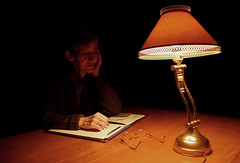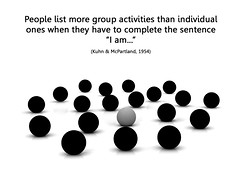How would learning look if we applied this principle to everything that had to be learned, anything that was “good for you,” but that wasn’t fun? Is it possible to apply “the fun theory” to all learning? Can we be creative enough designers to do this?

If I Had Something to Say by re_birf
Attribution License
This week we’ve been asked to jot down / sketch / brainstorm some ideas about our final design project. I was pretty stumped for a while, and I’m still not sure I’ve really got any ideas. I have several jotted down in my (paper) notebook and have been letting them “sit” in my mind for the last 4 or 5 days. Generally they all come back to writing and how to make it more of a social, interactive experience. Basically, I am uncomfortable (always have been) with the stereotypical image of “writer in solitude.” While I agree that at times one can write better when sitting alone, I also think good writers can emerge from a supported community. It takes some balance. I’m not really keen on teaching / instructing people how to become better writers in solitude. I’ll leave that for Sark, Natalie Goldberg, and Julia Cameron. I’m much more interested in how to capitalize on the hive mind and create some solid pieces of Writing For The People.

i am by Will Lion
Attribution-NonCommercial-NoDerivs License
Robert Scoble tried a variation of this using FriendFeed and Twitter, but I am much more interested in the idea of having some kind of platform that makes this all possible — that your audience can give you feedback as the ideas are being generated, and that parts of the writer’s words can be shared, and critiqued, before the piece is “finished.” Or perhaps the piece is never finished? I’d like there to be some element of audio / video, as well, so that users can comment this way and so that the focus is not entirely text-based. I basically want writing — that is, communicating via text — to not be as laborious and text-heavy as it is now. In order to blog these days, you have to be pretty text literate. And while that is fine for those of us who are verbal and educated, what about twelve-year-olds who have something to put out into the world, who want to refine their writing, but want some help and interaction to make their writing really phenomenal?
Perhaps I’m thinking too grandiose at the moment…
What’s been sticking out to me when reading Saffer, Sharp, Norman, and Adams is how important it is for the affordances of the interface to be almost instinctual, or intuitive. I also am intrigued by the feedback/ feed-forward ideas Saffer discusses in Chapter 7; it is striking to me how few programs / platforms incorporate this. The key, I guess, is to have everything seem simple to the user but in reality the complexity is all hidden from the user. Which has got me thinking — if it is intuitive to me, how will I know it is intuitive to others? Saffer in particular talks about how so many designers design things for other designers, and how this is just not cool. I have to agree. So I am wondering — hoping? optimistically? naively? — that not being a designer myself or having that background will actually be an advantage in this particular project. Or is that what every designer thinks when they first start out… ? 😉 I suppose it comes back to what we’ve been learning in every course so far — a tenet that is fundamental to educators in general — know your user. Do research, talk to them, study them, find out how they will use things, how they think. This reminds me also how intrigued I was about all the user research that went into Quest Atlantis, having read about this for a different course. Knowing your user is key, and I suppose one cannot assume ever that they are just like oneself! 🙂
I have to admit that I’m really also loving the ideas of one of my classmates, Poukhan. Check out her ideas. I am tempted to scrap my interactive writing idea altogether and ask if I can join her!
Like this? You might also enjoy these:

Stay Warm by Erik Charlton
Attribution License
Frank gives us a few web resources now and then that he wants us to look at; whether for inspiration or understanding, I’m unsure. Whatever the case, they are usually interesting reading / viewing, and probably things I would not find myself were I surfing around on the ‘net. Communication Arts magazine has reviewed many different kinds of interaction designs, and given awards to a few. They’re worth checking out, if for no other reason than just to see some of the new, cool, hot designs on the market these days — everything from web design to physical spaces. I’ve been bouncing around their site, looking at different designs and trying to understand what makes them “good.” While sometimes that is obvious, what I find even more fascinating than the designs themselves are the responses to the question CA mag asks of the designer:
What was the most challenging aspect of the project?
Some responses: (emphasis mine)
- “The most challenging part of this project was keeping it simple, staying true to the core ideas and avoiding ‘feature creep.’ . . . I had to stay focused on the original goal—not reinventing the wheel but rather enhancing it.” Sebastian Bettencourt, art director/writer/interface designer/information architect/project design and development, Beyond The Fold
- “One of the primary challenges to designing TokBox was understanding and embracing user interactions that are unique to live video calling.” Chris Fox, design director, TokBox
- “For the Loudspeaker team, the big challenge was caring for the original idea—amplifying the voice of a great cause—as we built the site.” Scott Brown, creative director, The LoudspeakerSite
- “It was a challenge to keep each individual story entertaining and short (there were many ideas that were thrown out because they were too long or just not fun to watch).” Trevor Van Meter, creative director; Luke Lutman, Flash programmer; and Brian McBrearty, composer, Crappy Cat
And this question:
Did you learn anything new during the process?
Responses:
- “I learned that inspiration comes from experience. It comes from rethinking everyday activities and from reconsidering everyday interactions.” Sebastian Bettencourt, art director/writer/interface designer/information architect/project design and development of Beyond The Fold
- “One of the first things we had to face was the huge risk of that transparency, and what it really meant. No approvals. No editing. In the end, it was actually freeing to give up all control to the audience.” Gary Koepke and Lance Jensen, executive creative directors, Modernista!
This has got me wondering about how design influences learning. How conscious are educators of keeping it simple, staying true to the original goals, giving students experiences (rather than instruction), and giving up control to the users? How would schools be different if we did all of this, all of the time? Would there still be schools? If so, what would they look like?